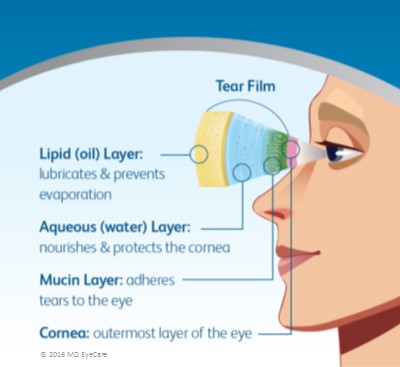About Dry Eye Syndrome
Dry eyes are very common, but left unaddressed, they can become debilitating.
Dry eye symptoms include:
|
✔ Sandy, gritty or burning feeling ✔ Itching or stinging ✔ Redness of the eyes ✔ Sensitivity to light ✔ Heavy eyelids |
✔ Contact lens discomfort ✔ Decreased tolerance for reading or working on computers ✔ Fatigued or aching eyes ✔ Filmy, blurred vision
|
What Causes Dry Eye Syndrome?
Dry eye syndrome is caused by a disruption in the tear production process. Normally, a thin film of tears coats the eyes to keep eyes sufficiently lubricated and vision optimal. This tear film consists of three layers – an inner mucous layer, a middle aqueous layer, and an outer lipid layer. If deficiency occurs in any of the three layers, dry eye symptoms can occur. Imbalances between tear production, drainage and retention can be caused by a number of factors. The prevalence of dry eyes increases with age; at 65 years, we have 60% less oil in our bodies than we did as teenagers. As well as being caused by the normal ageing of tear glands, dry eye syndrome can also occur due to extended contact lens wear, medications, symptoms of menopause, eye surgery such as LASIK, seasonal and environmental factors, air pollution, air travel, computer-related eye strain, inadequate diet and other factors.
Cross Section of a Healthy Tear FilmA Healthy Tear Film:✔ Protects & lubricates the eye ✔ Reduces the risk of eye infection ✔ Washes away foreign particles ✔ Keeps the eye comfortable & clear |
 |
Contact Lens Wear
Since contact lenses rest directly on the cornea, wearing contact lenses for extended time periods can lead to a decrease in the amount of oxygen that reaches your eyes. Bacteria and other infection-causing agents can accumulate on contact lenses also, especially as lenses get older and deposits build up on their surfaces, contributing to inflammatory issues. Contact lens solutions that contain preservatives can also cause irritation to the corneal surface, causing dry eye symptoms.
Medications
Dry eye can be a side effect of some medications, including antihistamines, nasal decongestants, sedatives, certain blood pressure medications, beta-blockers, certain antibiotics, certain psychiatric medications, Parkinson’s medications, birth control pills, diuretics, appetite suppressants, and anti-depressants.
Hormonal Changes
Changes in tear production can cause dry eye in women who have symptoms of menopause. Women on hormone replacement therapy may also experience dry eye symptoms. Women taking estrogen are 70 percent more likely to experience dry eyes, and those taking estrogen and progesterone have a 30 percent increased risk of developing dry eyes. Before menopause, it is understood that the greater a woman’s testosterone, the fewer tears produced, and the greater their estrogen, the greater tears produced. During menopause, however, this reverses. Research is emerging about the role hormones play in the lubrication of eyes, but it is understood that dry eyes can result from a deficiency in estrogen, progesterone, or testosterone, or possibly from an imbalance of any of the three.
LASIK and other Eye Surgery
Dry eye is an extremely common complication of eye surgery such as LASIK, with more than half of all patients experiencing dry eyes after the procedure. LASIK causes some nerves in the cornea to be cut, which reduces corneal sensitivity to some degree. In response, your eyes may not sense the need for lubrication, causing your body to produce fewer tears, leading to dry eye syndrome. Dry eyes after LASIK can cause both discomfort and less than optimal visual outcomes, with aqueous tear production reduced and wound healing delayed. The condition usually resolves after a few months; however, in some cases, dry eye symptoms can continue for several months. Cataract surgery has also been found to exacerbate pre-existing dry eye and to induce dry eye in patients with healthy corneas. As with LASIK and other eye surgeries, postoperative dry eyes can affect visual outcomes and recovery time.
Environmental Factors
Dry eye can be a symptom of chronic inflammation of the conjunctiva, the membrane lining the eyelid and covering the front part of the eye or the lacrimal gland. Chronic conjunctivitis can be caused by exposure to certain irritants such as air pollution, drafts from air conditioning or heating, climate conditions or seasonal allergy.
Air Travel
Low relative humidity conditions such as those experienced in airplane cabins during flights causes an increase in aqueous tear evaporation that intensifies dry eye symptoms. Increases in evaporative rates during air travel are experienced both by people with existing dry eye issues and also by people with no previous history of dry eye syndrome. Duration and frequency of flying increases the likelihood of dry eye syndrome.
Computer-Related Eye Strain
The infrequent blinking associated with staring at computer or video screens can lead to dry eye symptoms. The normal blink rate in human eyes is 16 to 22 blinks per minute. Studies have shown that the blink rate decreases to as low as 6 to 8 blinks per minute for persons working on computer screens. Also, the focusing effort required for extended periods of computer work puts strain on the ciliary muscles of the eye, further exacerbating inflammatory issues.

